Financial Management and Decision Making, Semester 1, 2024
VerifiedAdded on 2023/06/08
|11
|1747
|274
Homework Assignment
AI Summary
This assignment solution covers key aspects of financial management and decision-making. It begins with the calculation of payback periods and net present values (NPV) for different projects, analyzing their viability and comparing their profitability. The solution then delves into ratio analysis, calculating and interpreting various financial ratios like gross profit margin, operating profit margin, return on capital employed, and liquidity ratios, to assess a company's performance over two years. Variance analysis is also performed, including sales, direct material, direct labor, and variable overhead variances, to evaluate the differences between budgeted and actual performance. Breakeven analysis is applied to determine breakeven points and margin of safety for product lines, along with an evaluation of its relevance in modern manufacturing. Finally, the assignment outlines the steps involved in setting a financial and cost controlling budget within a large organization. The assignment demonstrates a solid understanding of financial principles and their practical application.
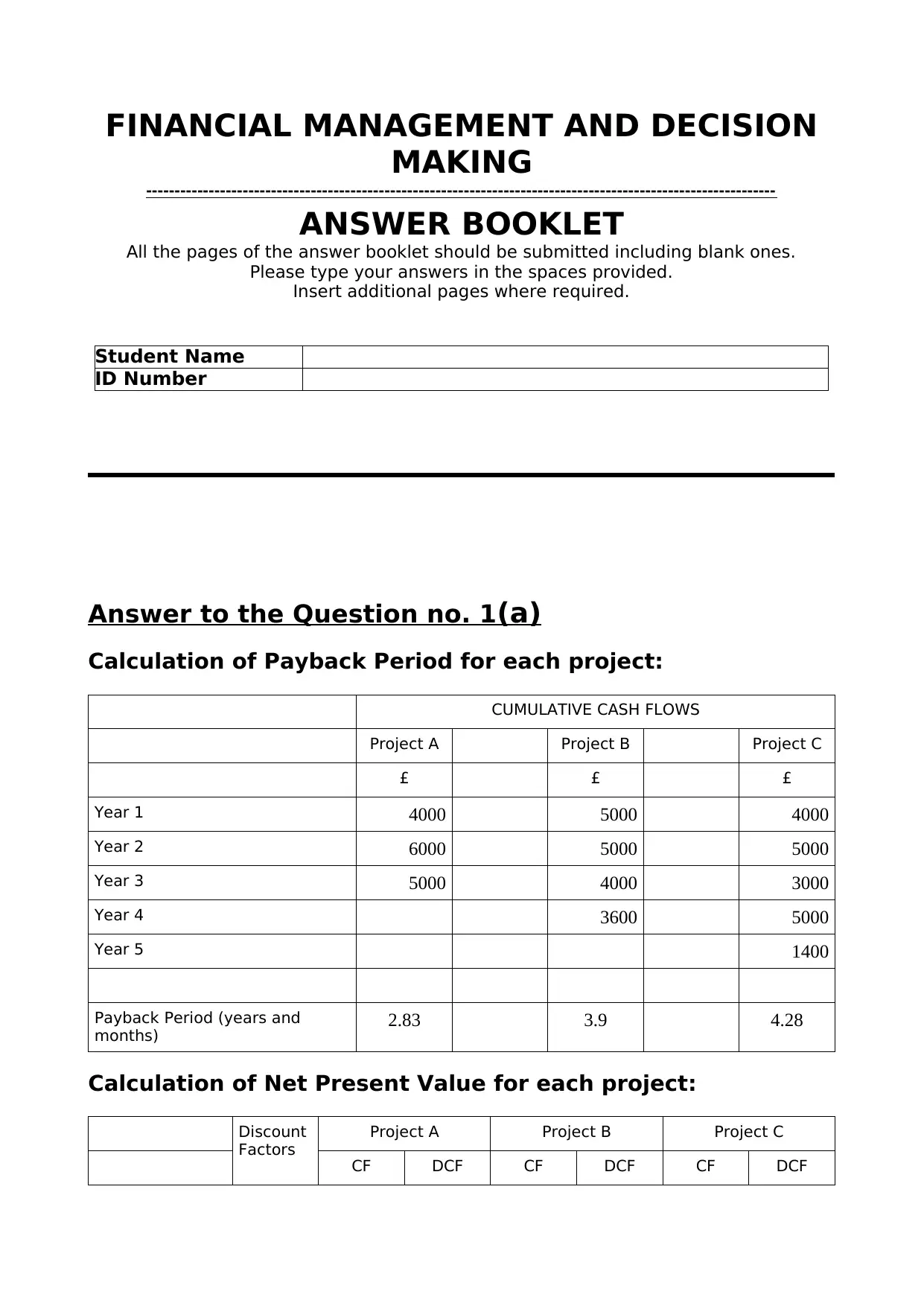
FINANCIAL MANAGEMENT AND DECISION
MAKING
---------------------------------------------------------------------------------------------------------------
ANSWER BOOKLET
All the pages of the answer booklet should be submitted including blank ones.
Please type your answers in the spaces provided.
Insert additional pages where required.
Student Name
ID Number
Answer to the Question no. 1(a)
Calculation of Payback Period for each project:
CUMULATIVE CASH FLOWS
Project A Project B Project C
£ £ £
Year 1 4000 5000 4000
Year 2 6000 5000 5000
Year 3 5000 4000 3000
Year 4 3600 5000
Year 5 1400
Payback Period (years and
months) 2.83 3.9 4.28
Calculation of Net Present Value for each project:
Discount
Factors
Project A Project B Project C
CF DCF CF DCF CF DCF
MAKING
---------------------------------------------------------------------------------------------------------------
ANSWER BOOKLET
All the pages of the answer booklet should be submitted including blank ones.
Please type your answers in the spaces provided.
Insert additional pages where required.
Student Name
ID Number
Answer to the Question no. 1(a)
Calculation of Payback Period for each project:
CUMULATIVE CASH FLOWS
Project A Project B Project C
£ £ £
Year 1 4000 5000 4000
Year 2 6000 5000 5000
Year 3 5000 4000 3000
Year 4 3600 5000
Year 5 1400
Payback Period (years and
months) 2.83 3.9 4.28
Calculation of Net Present Value for each project:
Discount
Factors
Project A Project B Project C
CF DCF CF DCF CF DCF
Paraphrase This Document
Need a fresh take? Get an instant paraphrase of this document with our AI Paraphraser
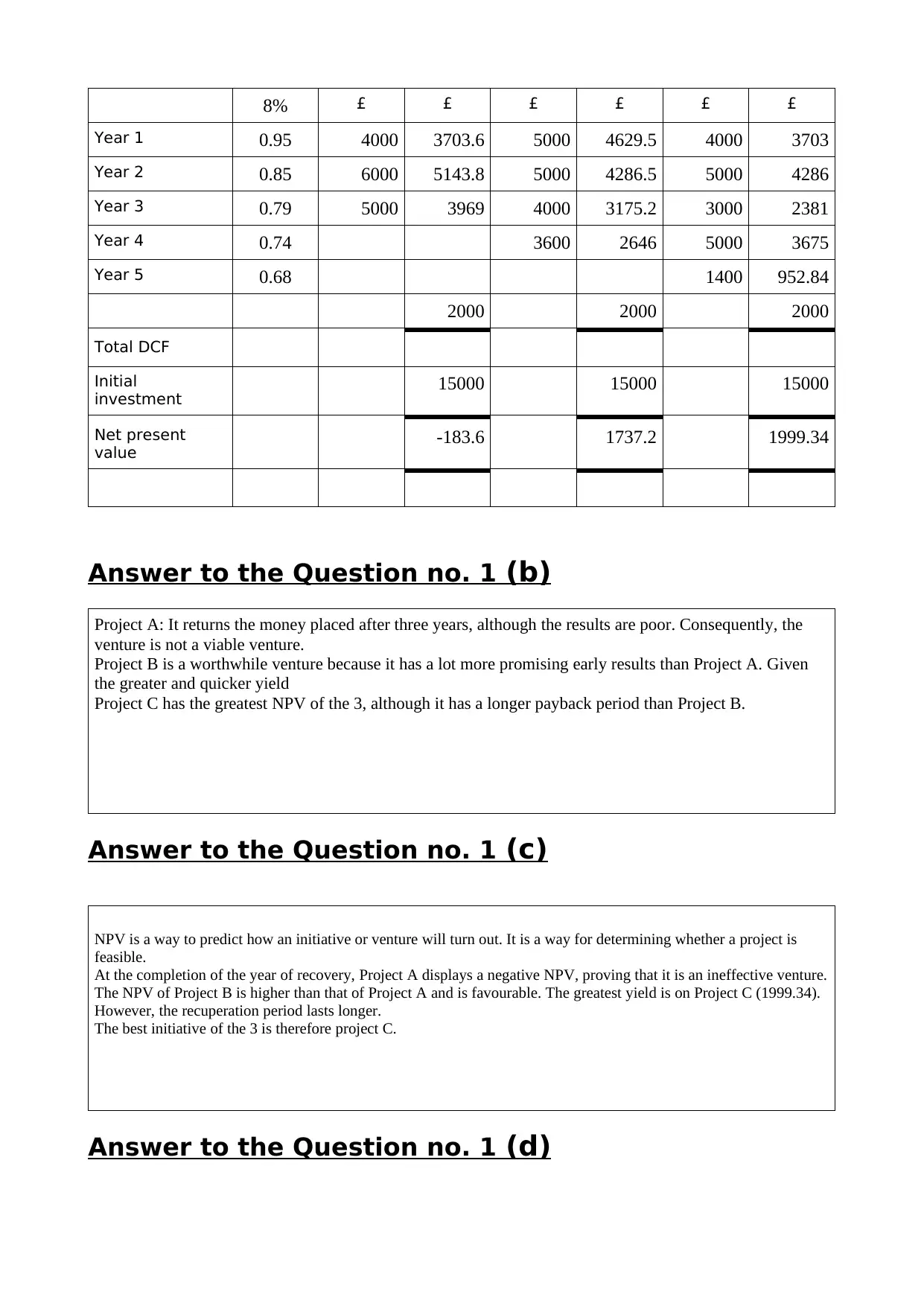
8% £ £ £ £ £ £
Year 1 0.95 4000 3703.6 5000 4629.5 4000 3703
Year 2 0.85 6000 5143.8 5000 4286.5 5000 4286
Year 3 0.79 5000 3969 4000 3175.2 3000 2381
Year 4 0.74 3600 2646 5000 3675
Year 5 0.68 1400 952.84
2000 2000 2000
Total DCF
Initial
investment 15000 15000 15000
Net present
value -183.6 1737.2 1999.34
Answer to the Question no. 1 (b)
Project A: It returns the money placed after three years, although the results are poor. Consequently, the
venture is not a viable venture.
Project B is a worthwhile venture because it has a lot more promising early results than Project A. Given
the greater and quicker yield
Project C has the greatest NPV of the 3, although it has a longer payback period than Project B.
Answer to the Question no. 1 (c)
NPV is a way to predict how an initiative or venture will turn out. It is a way for determining whether a project is
feasible.
At the completion of the year of recovery, Project A displays a negative NPV, proving that it is an ineffective venture.
The NPV of Project B is higher than that of Project A and is favourable. The greatest yield is on Project C (1999.34).
However, the recuperation period lasts longer.
The best initiative of the 3 is therefore project C.
Answer to the Question no. 1 (d)
Year 1 0.95 4000 3703.6 5000 4629.5 4000 3703
Year 2 0.85 6000 5143.8 5000 4286.5 5000 4286
Year 3 0.79 5000 3969 4000 3175.2 3000 2381
Year 4 0.74 3600 2646 5000 3675
Year 5 0.68 1400 952.84
2000 2000 2000
Total DCF
Initial
investment 15000 15000 15000
Net present
value -183.6 1737.2 1999.34
Answer to the Question no. 1 (b)
Project A: It returns the money placed after three years, although the results are poor. Consequently, the
venture is not a viable venture.
Project B is a worthwhile venture because it has a lot more promising early results than Project A. Given
the greater and quicker yield
Project C has the greatest NPV of the 3, although it has a longer payback period than Project B.
Answer to the Question no. 1 (c)
NPV is a way to predict how an initiative or venture will turn out. It is a way for determining whether a project is
feasible.
At the completion of the year of recovery, Project A displays a negative NPV, proving that it is an ineffective venture.
The NPV of Project B is higher than that of Project A and is favourable. The greatest yield is on Project C (1999.34).
However, the recuperation period lasts longer.
The best initiative of the 3 is therefore project C.
Answer to the Question no. 1 (d)
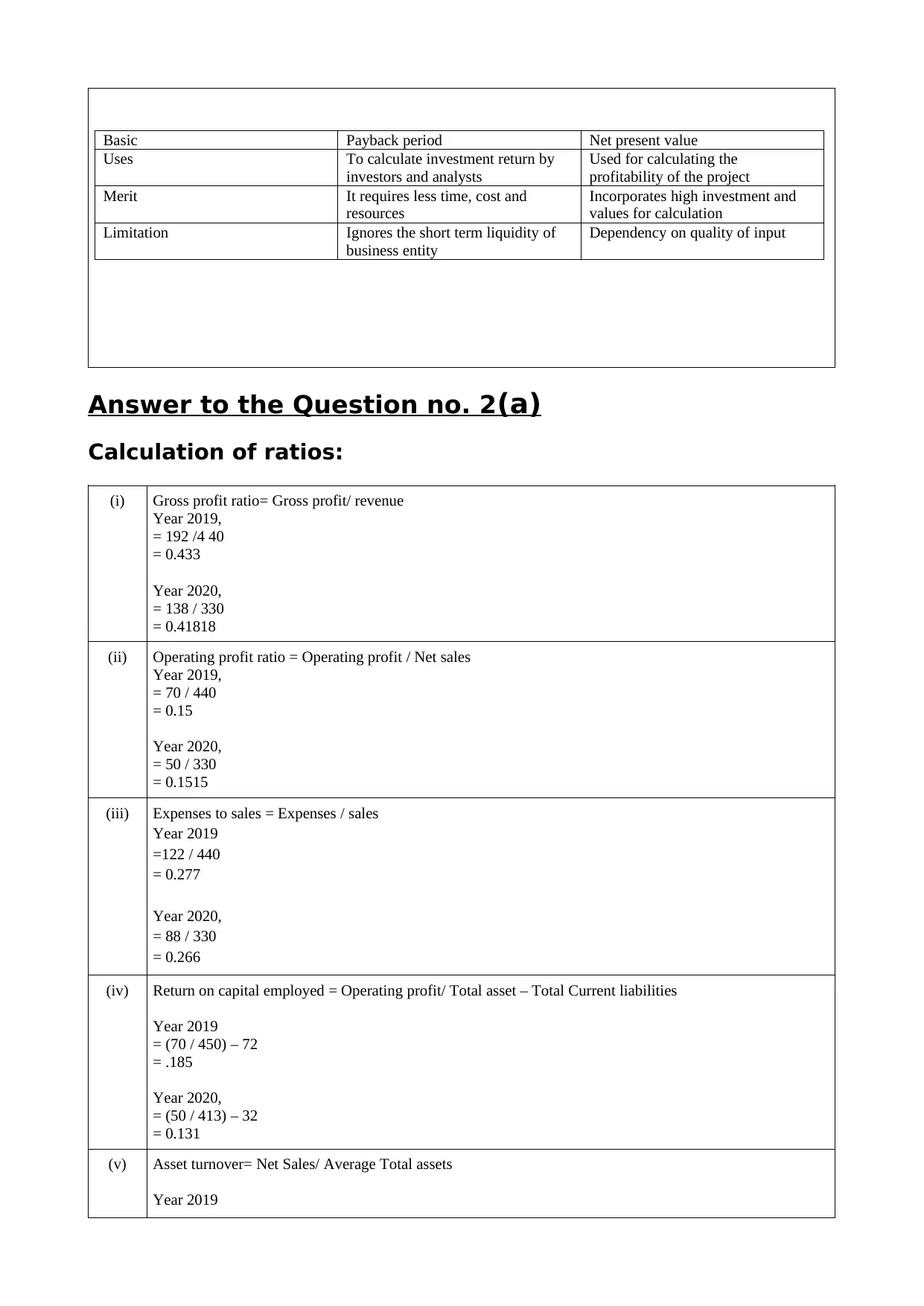
Basic Payback period Net present value
Uses To calculate investment return by
investors and analysts
Used for calculating the
profitability of the project
Merit It requires less time, cost and
resources
Incorporates high investment and
values for calculation
Limitation Ignores the short term liquidity of
business entity
Dependency on quality of input
Answer to the Question no. 2(a)
Calculation of ratios:
(i) Gross profit ratio= Gross profit/ revenue
Year 2019,
= 192 /4 40
= 0.433
Year 2020,
= 138 / 330
= 0.41818
(ii) Operating profit ratio = Operating profit / Net sales
Year 2019,
= 70 / 440
= 0.15
Year 2020,
= 50 / 330
= 0.1515
(iii) Expenses to sales = Expenses / sales
Year 2019
=122 / 440
= 0.277
Year 2020,
= 88 / 330
= 0.266
(iv) Return on capital employed = Operating profit/ Total asset – Total Current liabilities
Year 2019
= (70 / 450) – 72
= .185
Year 2020,
= (50 / 413) – 32
= 0.131
(v) Asset turnover= Net Sales/ Average Total assets
Year 2019
Uses To calculate investment return by
investors and analysts
Used for calculating the
profitability of the project
Merit It requires less time, cost and
resources
Incorporates high investment and
values for calculation
Limitation Ignores the short term liquidity of
business entity
Dependency on quality of input
Answer to the Question no. 2(a)
Calculation of ratios:
(i) Gross profit ratio= Gross profit/ revenue
Year 2019,
= 192 /4 40
= 0.433
Year 2020,
= 138 / 330
= 0.41818
(ii) Operating profit ratio = Operating profit / Net sales
Year 2019,
= 70 / 440
= 0.15
Year 2020,
= 50 / 330
= 0.1515
(iii) Expenses to sales = Expenses / sales
Year 2019
=122 / 440
= 0.277
Year 2020,
= 88 / 330
= 0.266
(iv) Return on capital employed = Operating profit/ Total asset – Total Current liabilities
Year 2019
= (70 / 450) – 72
= .185
Year 2020,
= (50 / 413) – 32
= 0.131
(v) Asset turnover= Net Sales/ Average Total assets
Year 2019
⊘ This is a preview!⊘
Do you want full access?
Subscribe today to unlock all pages.

Trusted by 1+ million students worldwide
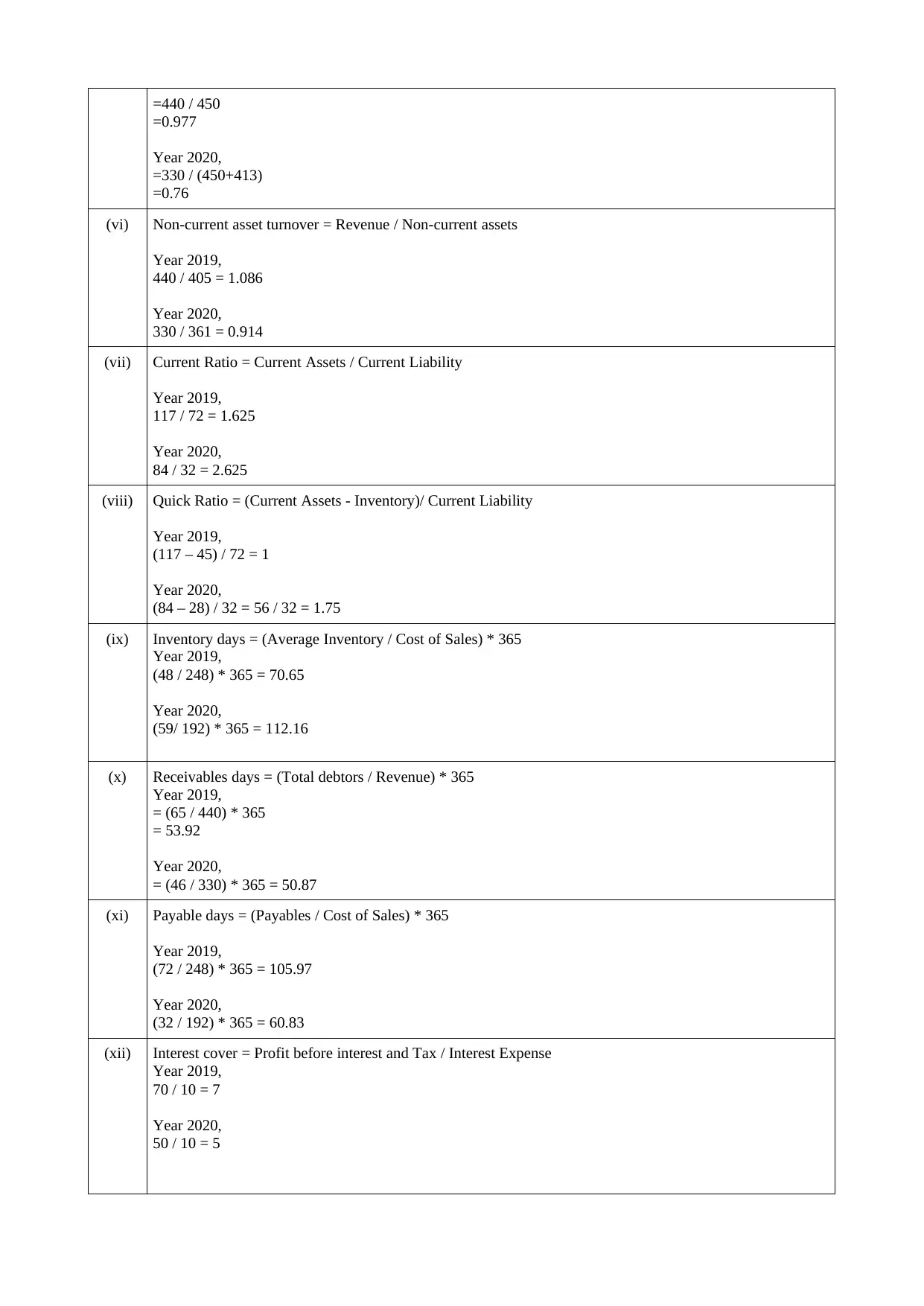
=440 / 450
=0.977
Year 2020,
=330 / (450+413)
=0.76
(vi) Non-current asset turnover = Revenue / Non-current assets
Year 2019,
440 / 405 = 1.086
Year 2020,
330 / 361 = 0.914
(vii) Current Ratio = Current Assets / Current Liability
Year 2019,
117 / 72 = 1.625
Year 2020,
84 / 32 = 2.625
(viii) Quick Ratio = (Current Assets - Inventory)/ Current Liability
Year 2019,
(117 – 45) / 72 = 1
Year 2020,
(84 – 28) / 32 = 56 / 32 = 1.75
(ix) Inventory days = (Average Inventory / Cost of Sales) * 365
Year 2019,
(48 / 248) * 365 = 70.65
Year 2020,
(59/ 192) * 365 = 112.16
(x) Receivables days = (Total debtors / Revenue) * 365
Year 2019,
= (65 / 440) * 365
= 53.92
Year 2020,
= (46 / 330) * 365 = 50.87
(xi) Payable days = (Payables / Cost of Sales) * 365
Year 2019,
(72 / 248) * 365 = 105.97
Year 2020,
(32 / 192) * 365 = 60.83
(xii) Interest cover = Profit before interest and Tax / Interest Expense
Year 2019,
70 / 10 = 7
Year 2020,
50 / 10 = 5
=0.977
Year 2020,
=330 / (450+413)
=0.76
(vi) Non-current asset turnover = Revenue / Non-current assets
Year 2019,
440 / 405 = 1.086
Year 2020,
330 / 361 = 0.914
(vii) Current Ratio = Current Assets / Current Liability
Year 2019,
117 / 72 = 1.625
Year 2020,
84 / 32 = 2.625
(viii) Quick Ratio = (Current Assets - Inventory)/ Current Liability
Year 2019,
(117 – 45) / 72 = 1
Year 2020,
(84 – 28) / 32 = 56 / 32 = 1.75
(ix) Inventory days = (Average Inventory / Cost of Sales) * 365
Year 2019,
(48 / 248) * 365 = 70.65
Year 2020,
(59/ 192) * 365 = 112.16
(x) Receivables days = (Total debtors / Revenue) * 365
Year 2019,
= (65 / 440) * 365
= 53.92
Year 2020,
= (46 / 330) * 365 = 50.87
(xi) Payable days = (Payables / Cost of Sales) * 365
Year 2019,
(72 / 248) * 365 = 105.97
Year 2020,
(32 / 192) * 365 = 60.83
(xii) Interest cover = Profit before interest and Tax / Interest Expense
Year 2019,
70 / 10 = 7
Year 2020,
50 / 10 = 5
Paraphrase This Document
Need a fresh take? Get an instant paraphrase of this document with our AI Paraphraser
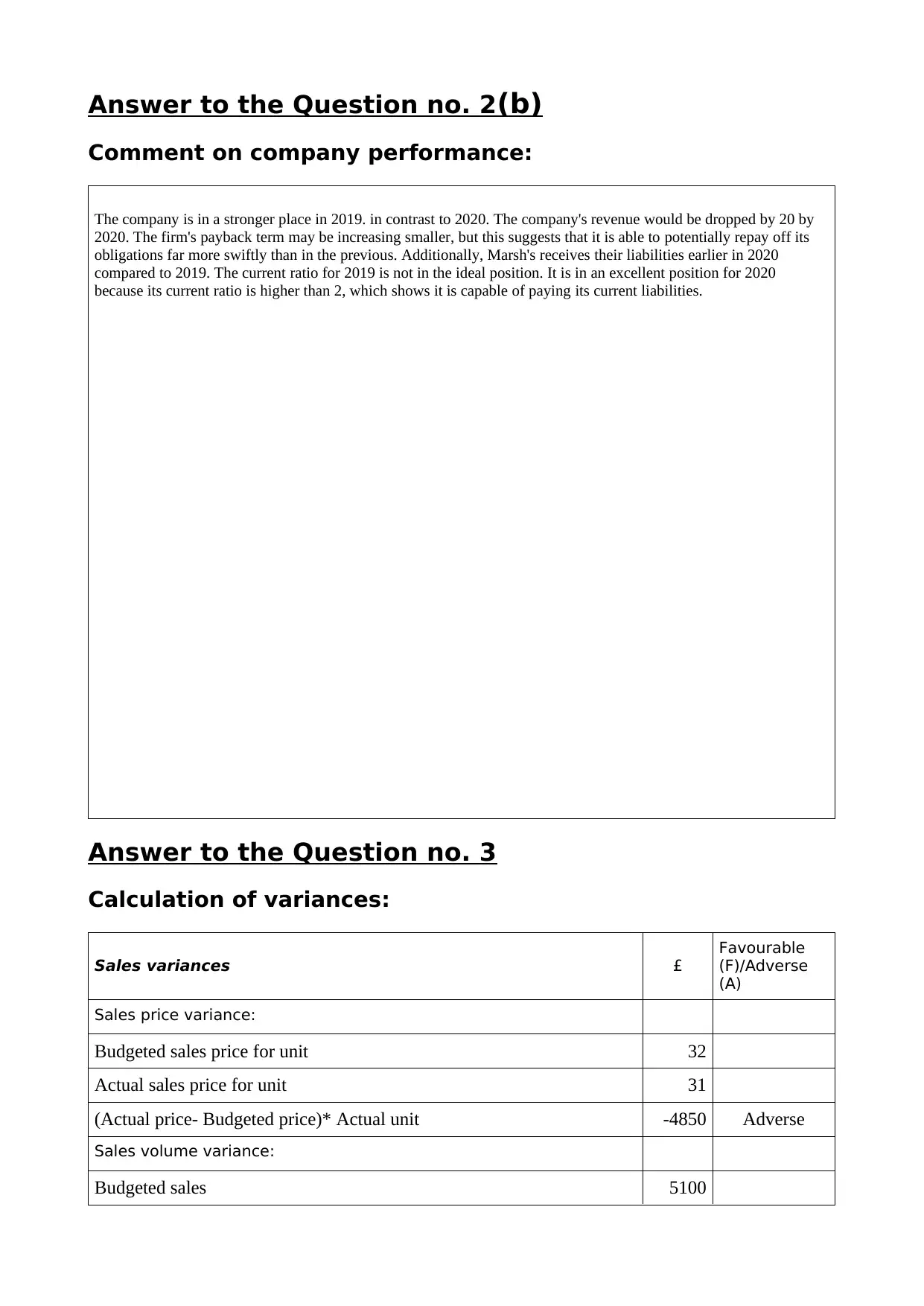
Answer to the Question no. 2(b)
Comment on company performance:
The company is in a stronger place in 2019. in contrast to 2020. The company's revenue would be dropped by 20 by
2020. The firm's payback term may be increasing smaller, but this suggests that it is able to potentially repay off its
obligations far more swiftly than in the previous. Additionally, Marsh's receives their liabilities earlier in 2020
compared to 2019. The current ratio for 2019 is not in the ideal position. It is in an excellent position for 2020
because its current ratio is higher than 2, which shows it is capable of paying its current liabilities.
Answer to the Question no. 3
Calculation of variances:
Sales variances £
Favourable
(F)/Adverse
(A)
Sales price variance:
Budgeted sales price for unit 32
Actual sales price for unit 31
(Actual price- Budgeted price)* Actual unit -4850 Adverse
Sales volume variance:
Budgeted sales 5100
Comment on company performance:
The company is in a stronger place in 2019. in contrast to 2020. The company's revenue would be dropped by 20 by
2020. The firm's payback term may be increasing smaller, but this suggests that it is able to potentially repay off its
obligations far more swiftly than in the previous. Additionally, Marsh's receives their liabilities earlier in 2020
compared to 2019. The current ratio for 2019 is not in the ideal position. It is in an excellent position for 2020
because its current ratio is higher than 2, which shows it is capable of paying its current liabilities.
Answer to the Question no. 3
Calculation of variances:
Sales variances £
Favourable
(F)/Adverse
(A)
Sales price variance:
Budgeted sales price for unit 32
Actual sales price for unit 31
(Actual price- Budgeted price)* Actual unit -4850 Adverse
Sales volume variance:
Budgeted sales 5100
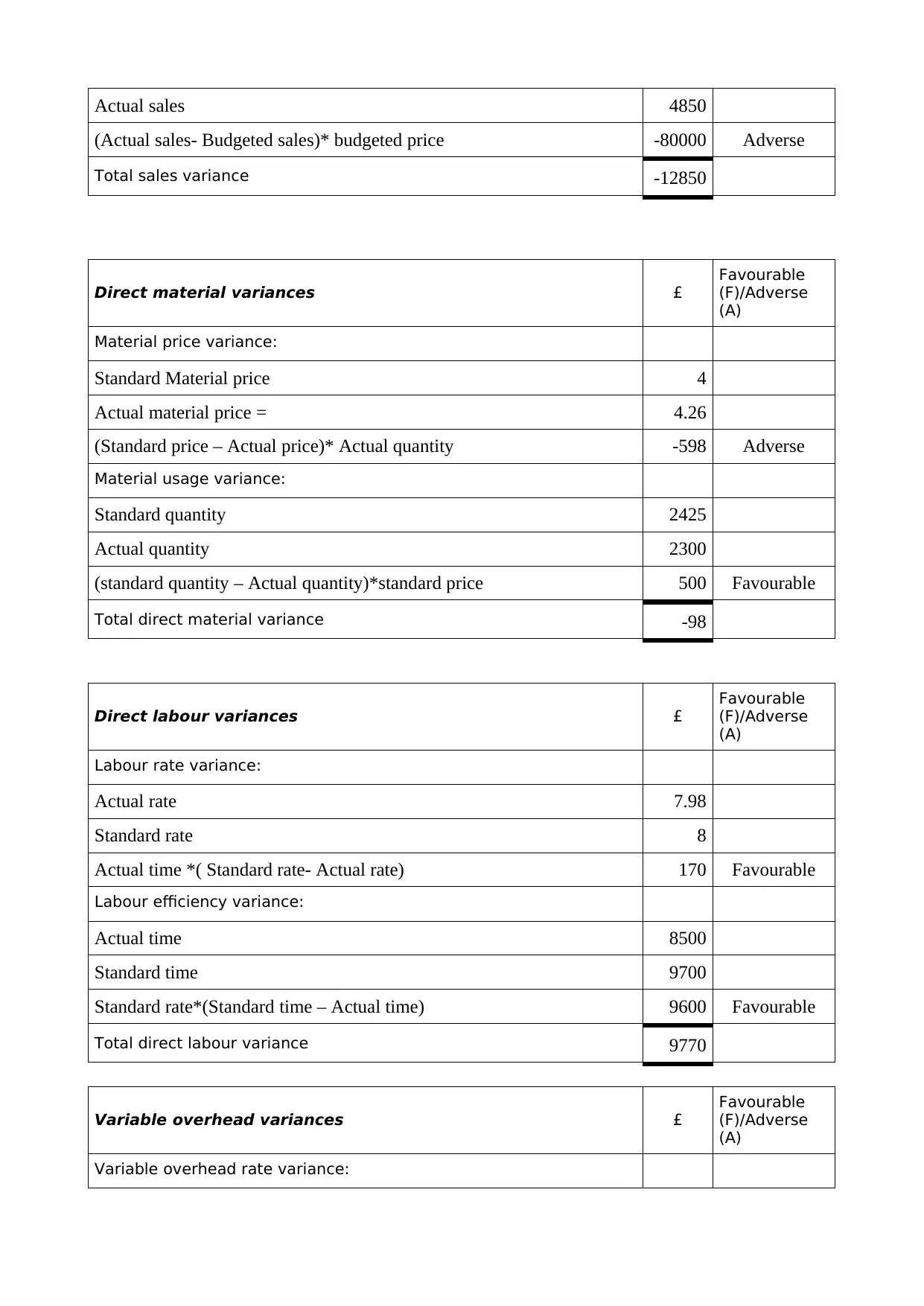
Actual sales 4850
(Actual sales- Budgeted sales)* budgeted price -80000 Adverse
Total sales variance -12850
Direct material variances £
Favourable
(F)/Adverse
(A)
Material price variance:
Standard Material price 4
Actual material price = 4.26
(Standard price – Actual price)* Actual quantity -598 Adverse
Material usage variance:
Standard quantity 2425
Actual quantity 2300
(standard quantity – Actual quantity)*standard price 500 Favourable
Total direct material variance -98
Direct labour variances £
Favourable
(F)/Adverse
(A)
Labour rate variance:
Actual rate 7.98
Standard rate 8
Actual time *( Standard rate- Actual rate) 170 Favourable
Labour efficiency variance:
Actual time 8500
Standard time 9700
Standard rate*(Standard time – Actual time) 9600 Favourable
Total direct labour variance 9770
Variable overhead variances £
Favourable
(F)/Adverse
(A)
Variable overhead rate variance:
(Actual sales- Budgeted sales)* budgeted price -80000 Adverse
Total sales variance -12850
Direct material variances £
Favourable
(F)/Adverse
(A)
Material price variance:
Standard Material price 4
Actual material price = 4.26
(Standard price – Actual price)* Actual quantity -598 Adverse
Material usage variance:
Standard quantity 2425
Actual quantity 2300
(standard quantity – Actual quantity)*standard price 500 Favourable
Total direct material variance -98
Direct labour variances £
Favourable
(F)/Adverse
(A)
Labour rate variance:
Actual rate 7.98
Standard rate 8
Actual time *( Standard rate- Actual rate) 170 Favourable
Labour efficiency variance:
Actual time 8500
Standard time 9700
Standard rate*(Standard time – Actual time) 9600 Favourable
Total direct labour variance 9770
Variable overhead variances £
Favourable
(F)/Adverse
(A)
Variable overhead rate variance:
⊘ This is a preview!⊘
Do you want full access?
Subscribe today to unlock all pages.

Trusted by 1+ million students worldwide
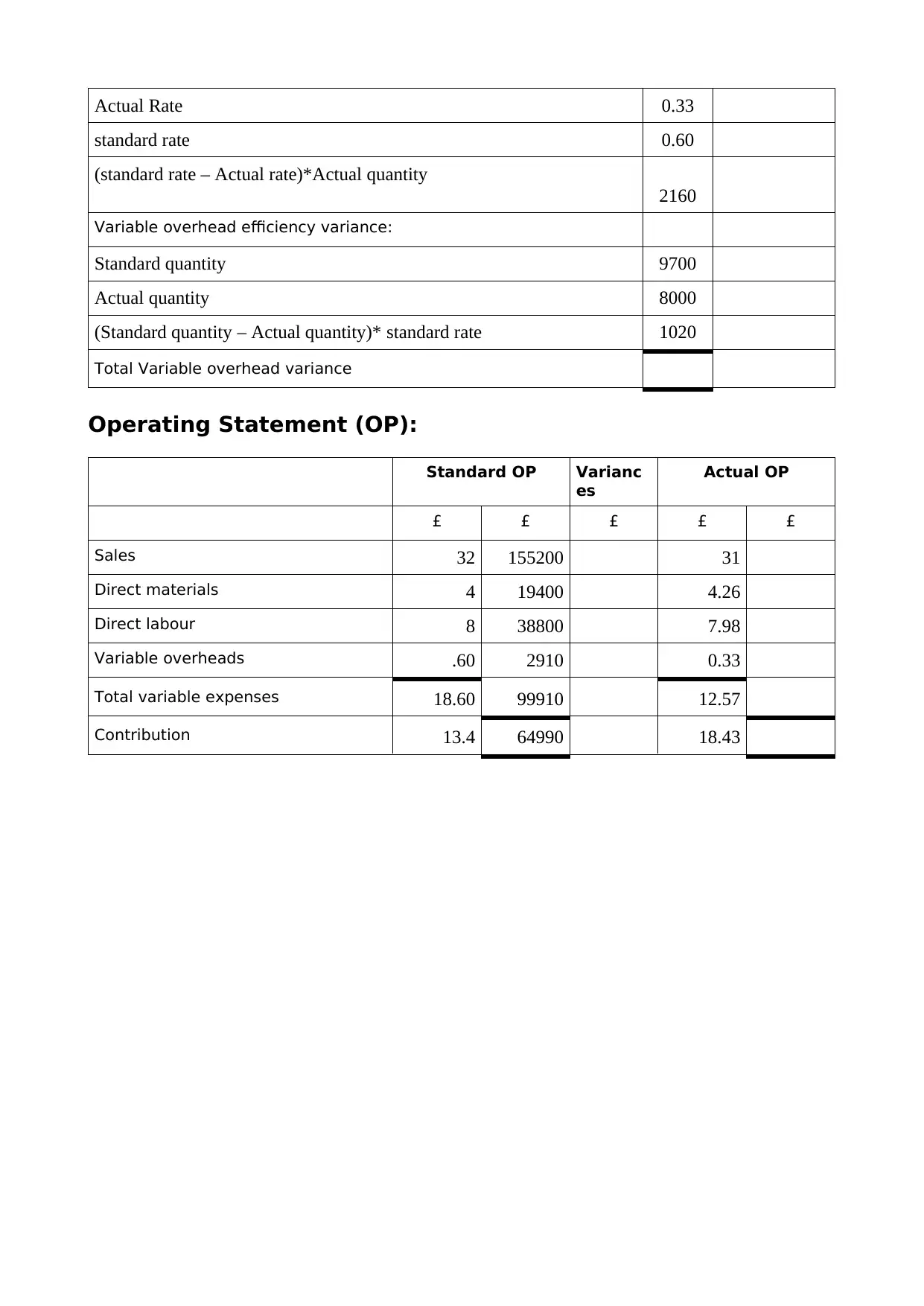
Actual Rate 0.33
standard rate 0.60
(standard rate – Actual rate)*Actual quantity
2160
Variable overhead efficiency variance:
Standard quantity 9700
Actual quantity 8000
(Standard quantity – Actual quantity)* standard rate 1020
Total Variable overhead variance
Operating Statement (OP):
Standard OP Varianc
es
Actual OP
£ £ £ £ £
Sales 32 155200 31
Direct materials 4 19400 4.26
Direct labour 8 38800 7.98
Variable overheads .60 2910 0.33
Total variable expenses 18.60 99910 12.57
Contribution 13.4 64990 18.43
standard rate 0.60
(standard rate – Actual rate)*Actual quantity
2160
Variable overhead efficiency variance:
Standard quantity 9700
Actual quantity 8000
(Standard quantity – Actual quantity)* standard rate 1020
Total Variable overhead variance
Operating Statement (OP):
Standard OP Varianc
es
Actual OP
£ £ £ £ £
Sales 32 155200 31
Direct materials 4 19400 4.26
Direct labour 8 38800 7.98
Variable overheads .60 2910 0.33
Total variable expenses 18.60 99910 12.57
Contribution 13.4 64990 18.43
Paraphrase This Document
Need a fresh take? Get an instant paraphrase of this document with our AI Paraphraser
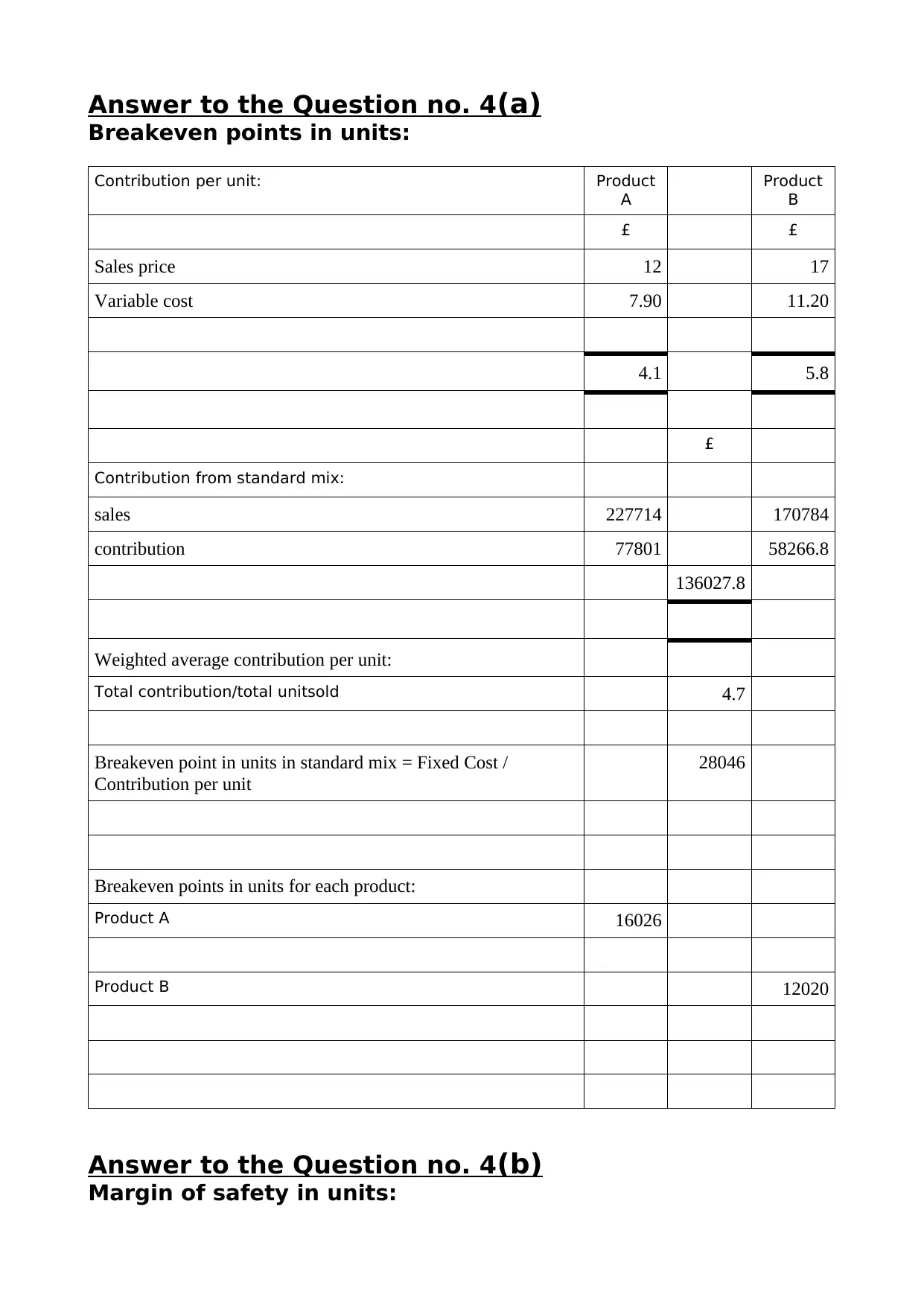
Answer to the Question no. 4(a)
Breakeven points in units:
Contribution per unit: Product
A
Product
B
£ £
Sales price 12 17
Variable cost 7.90 11.20
4.1 5.8
£
Contribution from standard mix:
sales 227714 170784
contribution 77801 58266.8
136027.8
Weighted average contribution per unit:
Total contribution/total unitsold 4.7
Breakeven point in units in standard mix = Fixed Cost /
Contribution per unit
28046
Breakeven points in units for each product:
Product A 16026
Product B 12020
Answer to the Question no. 4(b)
Margin of safety in units:
Breakeven points in units:
Contribution per unit: Product
A
Product
B
£ £
Sales price 12 17
Variable cost 7.90 11.20
4.1 5.8
£
Contribution from standard mix:
sales 227714 170784
contribution 77801 58266.8
136027.8
Weighted average contribution per unit:
Total contribution/total unitsold 4.7
Breakeven point in units in standard mix = Fixed Cost /
Contribution per unit
28046
Breakeven points in units for each product:
Product A 16026
Product B 12020
Answer to the Question no. 4(b)
Margin of safety in units:
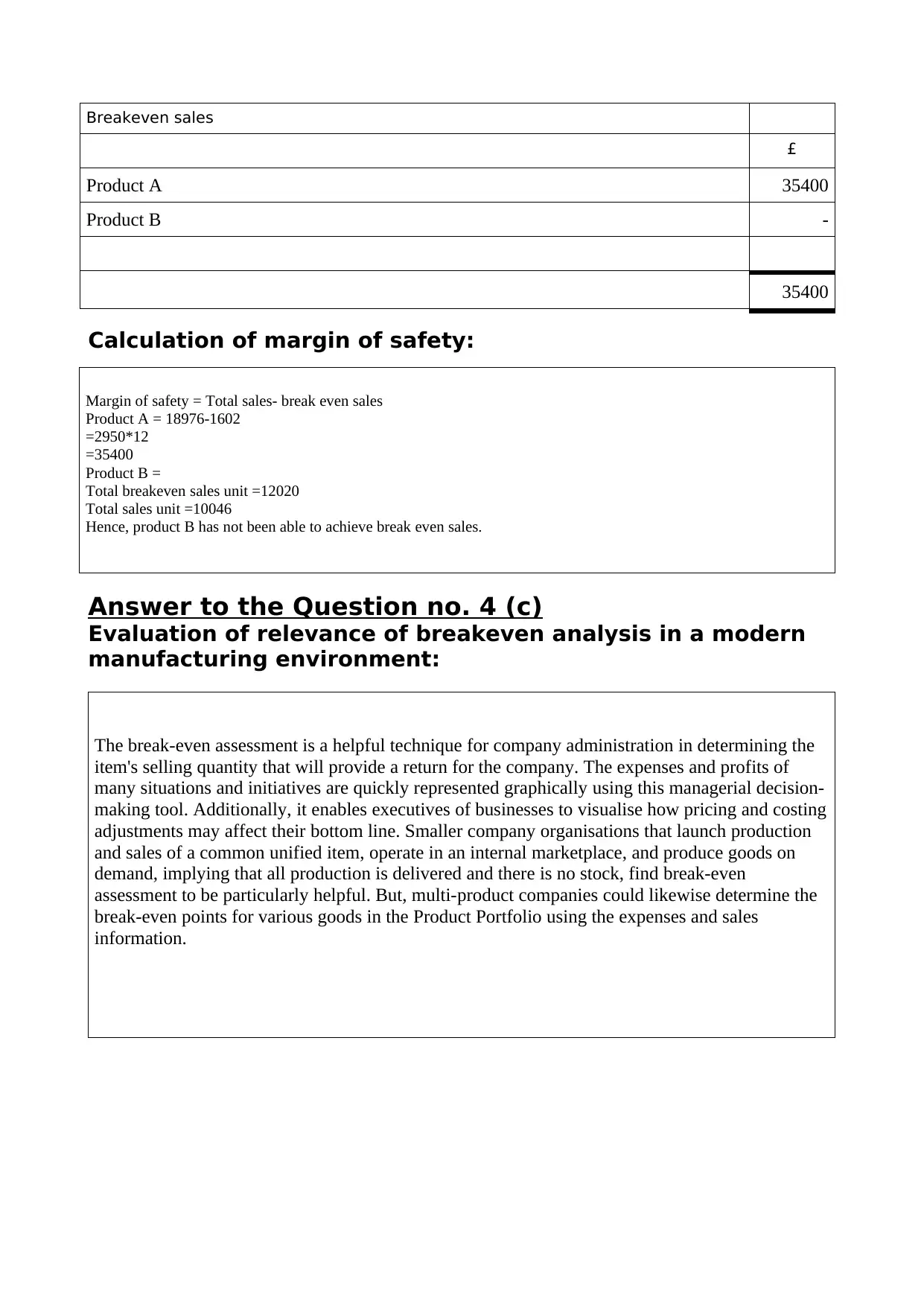
Breakeven sales
£
Product A 35400
Product B -
35400
Calculation of margin of safety:
Margin of safety = Total sales- break even sales
Product A = 18976-1602
=2950*12
=35400
Product B =
Total breakeven sales unit =12020
Total sales unit =10046
Hence, product B has not been able to achieve break even sales.
Answer to the Question no. 4 (c)
Evaluation of relevance of breakeven analysis in a modern
manufacturing environment:
The break-even assessment is a helpful technique for company administration in determining the
item's selling quantity that will provide a return for the company. The expenses and profits of
many situations and initiatives are quickly represented graphically using this managerial decision-
making tool. Additionally, it enables executives of businesses to visualise how pricing and costing
adjustments may affect their bottom line. Smaller company organisations that launch production
and sales of a common unified item, operate in an internal marketplace, and produce goods on
demand, implying that all production is delivered and there is no stock, find break-even
assessment to be particularly helpful. But, multi-product companies could likewise determine the
break-even points for various goods in the Product Portfolio using the expenses and sales
information.
£
Product A 35400
Product B -
35400
Calculation of margin of safety:
Margin of safety = Total sales- break even sales
Product A = 18976-1602
=2950*12
=35400
Product B =
Total breakeven sales unit =12020
Total sales unit =10046
Hence, product B has not been able to achieve break even sales.
Answer to the Question no. 4 (c)
Evaluation of relevance of breakeven analysis in a modern
manufacturing environment:
The break-even assessment is a helpful technique for company administration in determining the
item's selling quantity that will provide a return for the company. The expenses and profits of
many situations and initiatives are quickly represented graphically using this managerial decision-
making tool. Additionally, it enables executives of businesses to visualise how pricing and costing
adjustments may affect their bottom line. Smaller company organisations that launch production
and sales of a common unified item, operate in an internal marketplace, and produce goods on
demand, implying that all production is delivered and there is no stock, find break-even
assessment to be particularly helpful. But, multi-product companies could likewise determine the
break-even points for various goods in the Product Portfolio using the expenses and sales
information.
⊘ This is a preview!⊘
Do you want full access?
Subscribe today to unlock all pages.

Trusted by 1+ million students worldwide
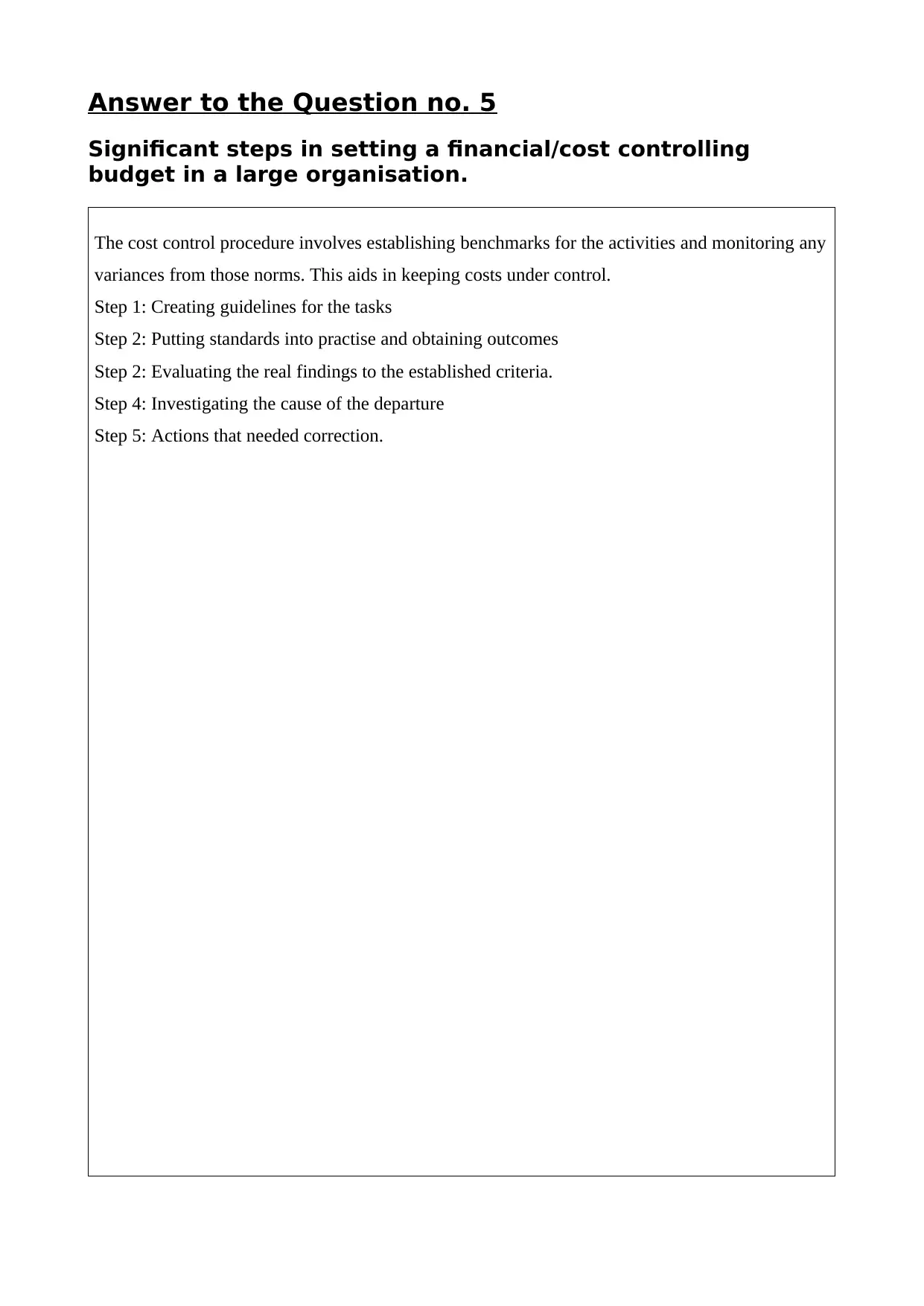
Answer to the Question no. 5
Significant steps in setting a financial/cost controlling
budget in a large organisation.
The cost control procedure involves establishing benchmarks for the activities and monitoring any
variances from those norms. This aids in keeping costs under control.
Step 1: Creating guidelines for the tasks
Step 2: Putting standards into practise and obtaining outcomes
Step 2: Evaluating the real findings to the established criteria.
Step 4: Investigating the cause of the departure
Step 5: Actions that needed correction.
Significant steps in setting a financial/cost controlling
budget in a large organisation.
The cost control procedure involves establishing benchmarks for the activities and monitoring any
variances from those norms. This aids in keeping costs under control.
Step 1: Creating guidelines for the tasks
Step 2: Putting standards into practise and obtaining outcomes
Step 2: Evaluating the real findings to the established criteria.
Step 4: Investigating the cause of the departure
Step 5: Actions that needed correction.
Paraphrase This Document
Need a fresh take? Get an instant paraphrase of this document with our AI Paraphraser

1 out of 11
Related Documents
Your All-in-One AI-Powered Toolkit for Academic Success.
+13062052269
info@desklib.com
Available 24*7 on WhatsApp / Email
![[object Object]](/_next/static/media/star-bottom.7253800d.svg)
Unlock your academic potential
Copyright © 2020–2025 A2Z Services. All Rights Reserved. Developed and managed by ZUCOL.




